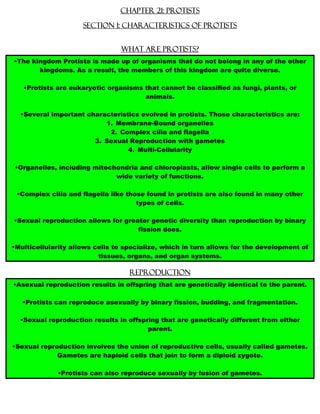
Section 1 Notes-Word After
- 1. Chapter 21: Protists Section 1: Characteristics of Protists What Are Protists? •The kingdom Protista is made up of organisms that do not belong in any of the other kingdoms. As a result, the members of this kingdom are quite diverse. •Protists are eukaryotic organisms that cannot be classified as fungi, plants, or animals. •Several important characteristics evolved in protists. Those characteristics are: 1. Membrane-Bound organelles 2. Complex cilia and flagella 3. Sexual Reproduction with gametes 4. Multi-Cellularity •Organelles, including mitochondria and chloroplasts, allow single cells to perform a wide variety of functions. •Complex cilia and flagella like those found in protists are also found in many other types of cells. •Sexual reproduction allows for greater genetic diversity than reproduction by binary fission does. •Multicellularity allows cells to specialize, which in turn allows for the development of tissues, organs, and organ systems. Reproduction •Asexual reproduction results in offspring that are genetically identical to the parent. •Protists can reproduce asexually by binary fission, budding, and fragmentation. •Sexual reproduction results in offspring that are genetically different from either parent. •Sexual reproduction involves the union of reproductive cells, usually called gametes. Gametes are haploid cells that join to form a diploid zygote. •Protists can also reproduce sexually by fusion of gametes.
- 2. Asexual Reproduction •Binary fission occurs when a unicellular organism reproduces by splitting in half after replicating its DNA. •The cells of a multicellular organism reproduce by mitosis with cytokinesis, often simply called mitosis. •Multicellular organisms do not undergo binary fission. Asexual Reproduction #2 •Budding is a form of asexual reproduction in which a part of the parent organism pinches off and forms a new organism. •Budding can occur in unicellular and multicellular organisms. •Budding differs from binary fission in that the offspring is smaller than the parent. Reproduction Asexual Reproduction #3 •In fragmentation, part of a multicellular organism breaks off and starts a new organism. •Fragmentation differs from budding in that budding is an action that is performed by the organism itself. Fragmentation is the result of an action that is done to an organism. •For example, an accident can result in fragmentation, but not budding. Sexual Reproduction •In many protists, sexual reproduction occurs as a response to environmental stress. •In some protists, the zygote secretes a tough outer coating and becomes a zygospore. •Zygospores can survive freezing, drying, and UV radiation. •In most unicellular protists, a mature organism is haploid. A haploid cell divides by binary fission to produce haploid gametes. •Two gametes fuse to form a diploid zygote and a zygospore. •When environmental conditions improve, meiosis occurs within the zygospore. Haploid cells break out of the zygospore and grow into mature cells.
- 3. •Many multicellular protists can reproduce both sexually and asexually. •This process, called alternation of generations, consists of multicellular haploid and multicellular diploid phases. • The diploid, spore-producing phase is called the sporophyte generation. •The adult sporophyte has sporangia, reproductive cells that produce haploid spores by meiosis. •The spores grow into multicellular haploid organisms. The haploid, gamete-producing phase is called the gametophyte generation. •The mature gametophyte produces haploid gametes by mitosis. •Two gametes fuse to form a diploid zygote. •The zygote divides to form a multicellular diploid organism. •This step begins the first stage of a new sporophyte generation.
